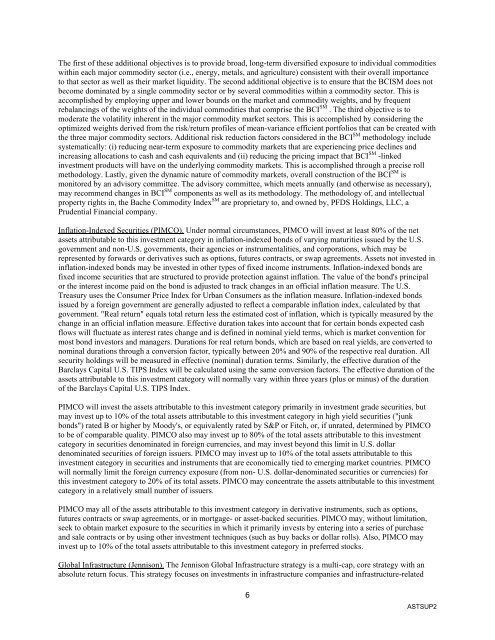Advanced Series Trust AST Academic Strategies Asset ... - Prudential
Advanced Series Trust AST Academic Strategies Asset ... - Prudential
Advanced Series Trust AST Academic Strategies Asset ... - Prudential
Create successful ePaper yourself
Turn your PDF publications into a flip-book with our unique Google optimized e-Paper software.
The first of these additional objectives is to provide broad, long-term diversified exposure to individual commodities<br />
within each major commodity sector (i.e., energy, metals, and agriculture) consistent with their overall importance<br />
to that sector as well as their market liquidity. The second additional objective is to ensure that the BCISM does not<br />
become dominated by a single commodity sector or by several commodities within a commodity sector. This is<br />
accomplished by employing upper and lower bounds on the market and commodity weights, and by frequent<br />
rebalancings of the weights of the individual commodities that comprise the BCI SM . The third objective is to<br />
moderate the volatility inherent in the major commodity market sectors. This is accomplished by considering the<br />
optimized weights derived from the risk/return profiles of mean-variance efficient portfolios that can be created with<br />
the three major commodity sectors. Additional risk reduction factors considered in the BCI SM methodology include<br />
systematically: (i) reducing near-term exposure to commodity markets that are experiencing price declines and<br />
increasing allocations to cash and cash equivalents and (ii) reducing the pricing impact that BCI SM -linked<br />
investment products will have on the underlying commodity markets. This is accomplished through a precise roll<br />
methodology. Lastly, given the dynamic nature of commodity markets, overall construction of the BCI SM is<br />
monitored by an advisory committee. The advisory committee, which meets annually (and otherwise as necessary),<br />
may recommend changes in BCI SM components as well as its methodology. The methodology of, and intellectual<br />
property rights in, the Bache Commodity Index SM are proprietary to, and owned by, PFDS Holdings, LLC, a<br />
<strong>Prudential</strong> Financial company.<br />
Inflation-Indexed Securities (PIMCO). Under normal circumstances, PIMCO will invest at least 80% of the net<br />
assets attributable to this investment category in inflation-indexed bonds of varying maturities issued by the U.S.<br />
government and non-U.S. governments, their agencies or instrumentalities, and corporations, which may be<br />
represented by forwards or derivatives such as options, futures contracts, or swap agreements. <strong>Asset</strong>s not invested in<br />
inflation-indexed bonds may be invested in other types of fixed income instruments. Inflation-indexed bonds are<br />
fixed income securities that are structured to provide protection against inflation. The value of the bond's principal<br />
or the interest income paid on the bond is adjusted to track changes in an official inflation measure. The U.S.<br />
Treasury uses the Consumer Price Index for Urban Consumers as the inflation measure. Inflation-indexed bonds<br />
issued by a foreign government are generally adjusted to reflect a comparable inflation index, calculated by that<br />
government. "Real return" equals total return less the estimated cost of inflation, which is typically measured by the<br />
change in an official inflation measure. Effective duration takes into account that for certain bonds expected cash<br />
flows will fluctuate as interest rates change and is defined in nominal yield terms, which is market convention for<br />
most bond investors and managers. Durations for real return bonds, which are based on real yields, are converted to<br />
nominal durations through a conversion factor, typically between 20% and 90% of the respective real duration. All<br />
security holdings will be measured in effective (nominal) duration terms. Similarly, the effective duration of the<br />
Barclays Capital U.S. TIPS Index will be calculated using the same conversion factors. The effective duration of the<br />
assets attributable to this investment category will normally vary within three years (plus or minus) of the duration<br />
of the Barclays Capital U.S. TIPS Index.<br />
PIMCO will invest the assets attributable to this investment category primarily in investment grade securities, but<br />
may invest up to 10% of the total assets attributable to this investment category in high yield securities ("junk<br />
bonds") rated B or higher by Moody's, or equivalently rated by S&P or Fitch, or, if unrated, determined by PIMCO<br />
to be of comparable quality. PIMCO also may invest up to 80% of the total assets attributable to this investment<br />
category in securities denominated in foreign currencies, and may invest beyond this limit in U.S. dollar<br />
denominated securities of foreign issuers. PIMCO may invest up to 10% of the total assets attributable to this<br />
investment category in securities and instruments that are economically tied to emerging market countries. PIMCO<br />
will normally limit the foreign currency exposure (from non- U.S. dollar-denominated securities or currencies) for<br />
this investment category to 20% of its total assets. PIMCO may concentrate the assets attributable to this investment<br />
category in a relatively small number of issuers.<br />
PIMCO may all of the assets attributable to this investment category in derivative instruments, such as options,<br />
futures contracts or swap agreements, or in mortgage- or asset-backed securities. PIMCO may, without limitation,<br />
seek to obtain market exposure to the securities in which it primarily invests by entering into a series of purchase<br />
and sale contracts or by using other investment techniques (such as buy backs or dollar rolls). Also, PIMCO may<br />
invest up to 10% of the total assets attributable to this investment category in preferred stocks.<br />
Global Infrastructure (Jennison). The Jennison Global Infrastructure strategy is a multi-cap, core strategy with an<br />
absolute return focus. This strategy focuses on investments in infrastructure companies and infrastructure-related<br />
6<br />
<strong>AST</strong>SUP2

















